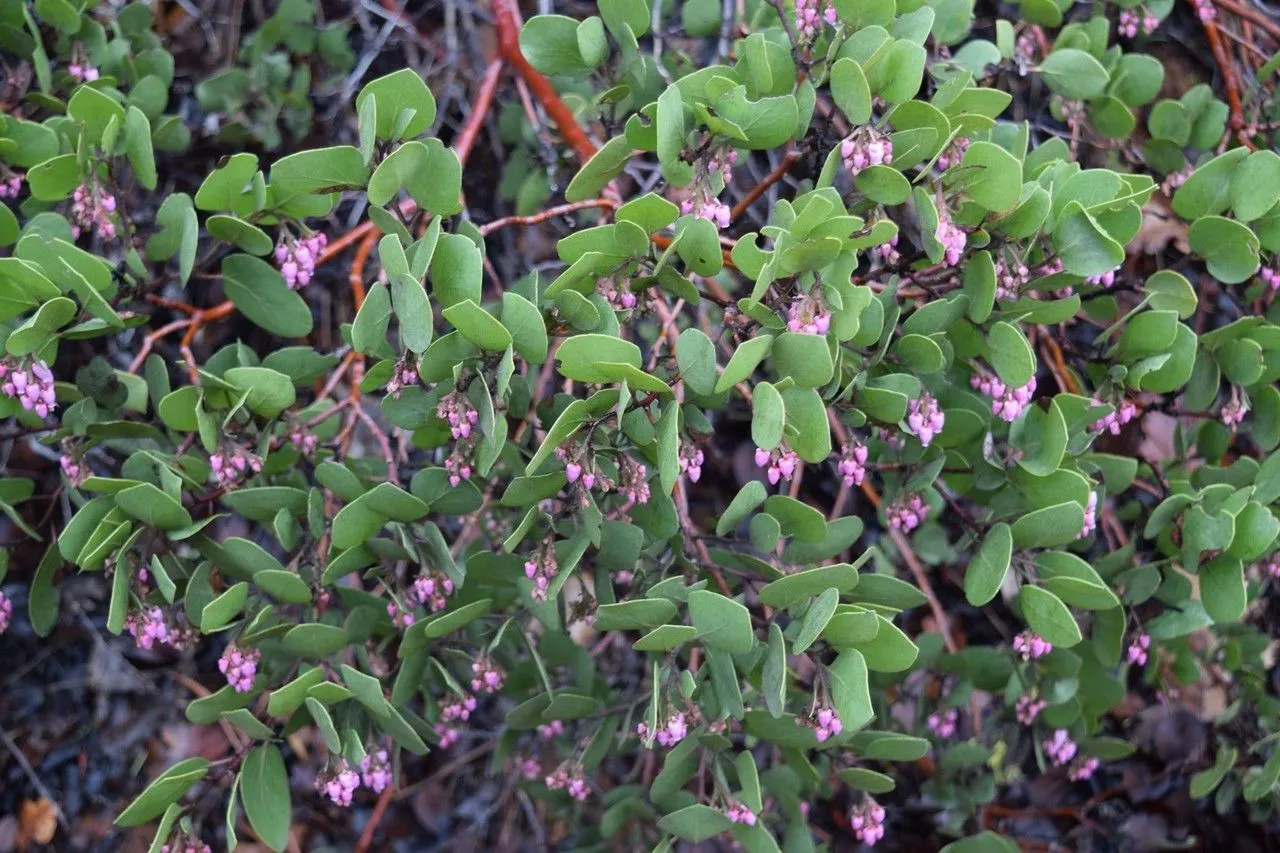
Author: Parry
Bibliography: Bull. Calif. Acad. Sci. 2: 491 (1887)
Year: 1887
Status: accepted
Rank: species
Genus: Arctostaphylos
Vegetable: False
Observations: NW. & NC. California
Whiteleaf manzanita, scientifically known as Arctostaphylos manzanita, is a remarkable plant species belonging to the Ericaceae family. This evergreen shrub is native to the northwest and north-central regions of California, where it thrives in the local chaparral and woodland ecosystems.
Discovered and officially described by Parry in 1887, with the findings published in the Bulletin of the California Academy of Sciences, the Whiteleaf manzanita has since drawn attention for its unique botanical characteristics. The shrub is noted for its striking appearance, featuring smooth, reddish-brown bark and dense, leathery leaves that are distinctly pale green or white on the underside, which lends the plant its common name.
During the blooming season, the Whiteleaf manzanita produces small, urn-shaped flowers that range in color from white to light pink. These blossoms are not only visually appealing but also play a crucial role in the local ecosystem, providing nectar for bees and other pollinators. Following the flowering period, the plant develops red, berry-like fruit that is a key food source for wildlife, including birds and mammals.
Adapted to survive in challenging conditions, Arctostaphylos manzanita is not only drought-tolerant but also capable of thriving in poor, rocky soils where other plants might struggle. Its resilience and ability to flourish in various environmental conditions make it a vital component of the Californian natural landscape.
The Whiteleaf manzanita is also valued in horticulture for its ornamental qualities and low-maintenance requirements. When incorporated into landscaping projects, it adds year-round beauty and structural interest while supporting biodiversity and ecological stability.
The enduring allure and ecological significance of Arctostaphylos manzanita underscore its important role in both natural habitats and cultivated settings. This plant continues to be an object of study and admiration, reflecting the diverse flora of California.
For further in-depth reading, refer to the publication in the Bulletin of the California Academy of Sciences, Volume 2, page 491, 1887, authored by Parry.
Eng: whiteleaf manzanita
En: Whiteleaf manzanita, Common manzanita, Bearberry, Manzamita
Taken Jun 2, 2018 by Daniel Barthelemy (cc-by-nc)
Taken Jun 2, 2018 by Daniel Barthelemy (cc-by-nc)
Taken Jun 2, 2018 by Daniel Barthelemy (cc-by-nc)
Taken Jun 2, 2018 by Daniel Barthelemy (cc-by-nc)
Taken Jul 26, 2017 by Brie Kapina (cc-by-sa)
Taken May 3, 2020 by Henkeová Barbora (cc-by-sa)
Taken Apr 8, 2021 by Jackelyn Kelley (cc-by-sa)
Taken May 30, 2021 by jenifer Bow-Wilson (cc-by-sa)
Taken Jan 10, 2022 by Dan Maxwell (cc-by-sa)
Taken Jan 24, 2022 by Meg Johnson (cc-by-sa)
Taken Mar 4, 2020 by Artemis (cc-by-sa)
Taken Feb 22, 2022 by maristela diaz (cc-by-sa)
Taken Mar 3, 2020 by Gigi Rock (cc-by-sa)
Taken May 14, 2020 by Ashley Escarate (cc-by-sa)
Taken Jun 12, 2019 by TheCroperty (cc-by-sa)
Taken Apr 8, 2021 by Jackelyn Kelley (cc-by-sa)
Taken May 3, 2020 by Henkeová Barbora (cc-by-sa)
Taken Jan 6, 2008 by EOL − Zoya Akulova (cc-by-nc)
Taken Jan 10, 2022 by Dan Maxwell (cc-by-sa)
Taken Apr 5, 2022 by Muscariaman (cc-by-sa)
Taken Apr 8, 2021 by Jackelyn Kelley (cc-by-sa)
Taken Mar 11, 2015 by EOL − Shasta-Trinity National Forest USDA Forest Service (public)
Taken Mar 14, 2016 by EOL − Loren Murch (cc-by-nc)
Taken Jan 20, 2014 by EOL − c michael hogan (cc-by-nc-sa)
Taken Mar 14, 2016 by EOL − Loren Murch (cc-by-nc)
Taken Mar 14, 2016 by EOL − Loren Murch (cc-by-nc)
Taken Mar 14, 2016 by EOL − Loren Murch (cc-by-nc)
Taken Feb 1, 2014 by EOL − c michael hogan (cc-by-nc-sa)
Taken Feb 2, 2014 by EOL − c michael hogan (cc-by-nc-sa)
Growth form>: Multiple Stem
Growth habit>: Shrub
Growth rate>: Slow
Ph maximum: 7.3
Ph minimum: 5.5
Family: Myrtaceae Author: (F.Muell.) K.D.Hill & L.A.S.Johnson Bibliography: Telopea 6: 402 (1995) Year: 1995 Status:…
Family: Rubiaceae Author: Pierre ex A.Froehner Bibliography: Notizbl. Bot. Gart. Berlin-Dahlem 1: 237 (1897) Year:…
Family: Sapindaceae Author: Koidz. Bibliography: J. Coll. Sci. Imp. Univ. Tokyo 32(1): 38 (1911) Year:…
Family: Asteraceae Author: A.Gray Bibliography: Pacif. Railr. Rep.: 107 (1857) Year: 1857 Status: accepted Rank:…
Family: Fabaceae Author: Medik. Bibliography: Vorles. Churpfälz. Phys.-Ökon. Ges. 2: 398 (1787) Year: 1787 Status:…
Family: Aspleniaceae Author: (Cav.) Alston Bibliography: Bull. Misc. Inform. Kew 1932: 309 (1932) Year: 1932…